

2015 K-12 Edition. What is on the five-year horizon for K-12 schools worldwide?
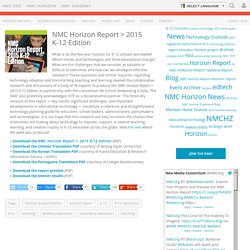
Which trends and technologies will drive educational change? What are the challenges that we consider as solvable or difficult to overcome, and how can we strategize effective solutions? These questions and similar inquiries regarding technology adoption and transforming teaching and learning steered the collaborative research and discussions of a body of 56 experts to produce the NMC Horizon Report > 2015 K-12 Edition, in partnership with the Consortium for School Networking (CoSN).
The NMC also gratefully acknowledges ISTE as a dissemination partner. The three key sections of this report — key trends, significant challenges, and important developments in educational technology — constitute a reference and straightforward technology planning guide for educators, school leaders, administrators, policymakers, and technologists. > Download the report preview (PDF)> Download the interim results (PDF) 2015 Higher Education Edition.
The NMC Horizon Report > 2015 Higher Education Edition is a collaborative effort between the NMC and the EDUCAUSE Learning Initiative (ELI).
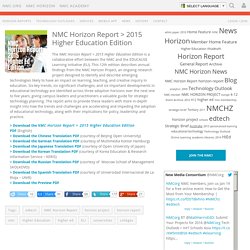
This 12th edition describes annual findings from the NMC Horizon Project, an ongoing research project designed to identify and describe emerging technologies likely to have an impact on learning, teaching, and creative inquiry in education. Six key trends, six significant challenges, and six important developments in educational technology are identified across three adoption horizons over the next one to five years, giving campus leaders and practitioners a valuable guide for strategic technology planning. The report aims to provide these leaders with more in-depth insight into how the trends and challenges are accelerating and impeding the adoption of educational technology, along with their implications for policy, leadership and practice.
Astronauts getting 3-D printer at International Space Station. Now Playing NASA awards 'space taxi' contract to Boeing and SpaceX CAPE CANAVERAL, Fla. – The 3-D printing boom is about to invade space.
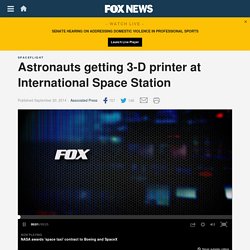
NASA is sending a 3-D printer to the International Space Station in hopes that astronauts will be able to one day fix their spacecraft by cranking out spare parts on the spot. The printer, made by a Northern California company called Made in Space, is among more than 5,000 pounds of space station cargo that's stuffed into a SpaceX Dragon capsule that was supposed to lift off before dawn Saturday. Rainy weather forced SpaceX to delay the launch until Sunday. Besides real-time replacement parts at the station, NASA envisions astronauts, in the decades ahead, making entire habitats at faraway destinations like Mars. Documentary 'Print the Legend' Goes Inside the World of 3D Printing. The genesis of and challenges to the 3D-printing revolution are subjects that take center stage in a new documentary called Print the Legend.
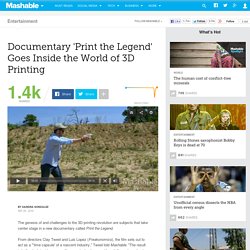
From directors Clay Tweel and Luis Lopez (Freakonomics), the film sets out to act as a "'time capsule' of a nascent industry," Tweel told Mashable. "The result is both a look inside a compelling new technology, and hopefully, a story about the challenges of growing any type of business, and facing the moral dilemmas our marketplace presents.
" That it is. The 90-minute Netflix Original documentary delves headfirst into major issues facing the 3D-printing industry, including 3D printed-guns, which is addressed in the above clip. Tweel said he knew "nothing" about 3D printing when he walked into the doors of MakerBot nearly two years ago, but working behind the scenes has taught him much about the industry. Print the Legend is now in theaters across New York and Los Angeles, and is also available on Netflix. Have something to add to this story? British Museum now lets you 3D print its artifacts using Sketchfab. Why visit a museum halfway around the world, when you can check out 3D scans, and print them from your own home?
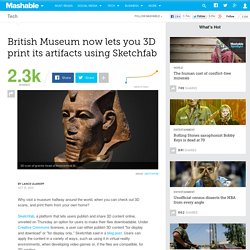
Sketchfab, a platform that lets users publish and share 3D content online, unveiled on Thursday an option for users to make their files downloadable. Under Creative Commons licenses, a user can either publish 3D content "for display and download" or "for display only," Sketchfab said in a blog post. Users can apply the content in a variety of ways, such as using it in virtual reality environments, when developing video games or, if the files are compatible, for 3D printing. The company also announced that it is hosting the "first downloadable collection" of the British Museum in London. Currently, the collection only has 14 3D models available, including various statues, a broken marble portrait of Julius Caesar, a marble bust of Zeus and a red granite sarcophagus.
Colossal marble bust of Zeus by britishmuseum on Sketchfab Pete Cashmore by lanceulanoff on Sketchfab. Manufacturing the future: How 3D printing went from pipe dream to your desktop. Maker Movement.pdf. 2014 Horizon Report. 3D Printing Will Transform Education.